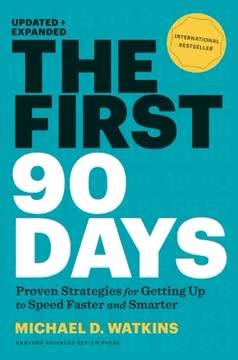Key Takeaways
1. Urgency is the essential first step for successful change in a turbulent world.
At the very beginning of any effort to make changes of any magnitude, if a sense of urgency is not high enough and complacency is not low enough, everything else becomes so much more difficult.
Change is accelerating. We live in an era of unprecedented turbulence driven by technology, globalization, and political shifts. This requires organizations to adapt constantly, but most change initiatives fail, often because the critical first step is mishandled.
The 70% failure rate. My research shows that over 70% of needed change efforts either fail to launch, fail to complete, or finish late and over budget. This massive drag on performance stems significantly from not creating a sufficiently high sense of urgency among enough people.
Foundation for success. Urgency isn't just one step; it's the foundation upon which all other successful change actions are built. Without it, efforts to form guiding teams, create visions, communicate, empower, generate wins, and anchor change in culture become exponentially harder and often collapse.
2. Complacency and False Urgency are pervasive, insidious, and dangerous opposites of True Urgency.
This is a false sense of urgency that may be even more destructive than complacency because it drains needed energy in activity and not productivity.
Complacency is invisible. Complacency is a feeling of contentment with the status quo, often born from past success, making people oblivious to external threats or opportunities. It's insidious because insiders rarely see it in themselves, justifying their inaction as rational or prudent.
False urgency is frantic. Unlike sleepy complacency, false urgency is high-energy activity driven by anxiety, anger, or frustration, not a focused determination to win. People run from meeting to meeting, produce endless reports, and engage in busywork that is more distracting and exhausting than productive.
Mistaking activity for urgency. A major problem today is confusing this frantic, unfocused activity with true urgency. This misdiagnosis leads people to believe they are addressing problems when they are merely spinning in circles, often making things worse by draining energy and fostering cynicism.
3. True Urgency is a focused, determined drive to win now, not frantic activity.
True urgency focuses on critical issues, not agendas overstuffed with the important and the trivial.
Action on critical issues. True urgency means action on critical issues is needed now, making real progress every single day. It's driven by a deep determination to move and win, not anxiety or anger.
Alert and proactive. People with true urgency are alert, constantly scanning the environment for relevant information. They focus on challenges central to success or survival, relentlessly looking for ways to rid themselves of low-value activities to free up time for what matters.
Positive and focused force. This isn't about stress or burnout; it's a highly positive, focused force. It directs energy towards important issues, encourages cooperation, and motivates people to launch smart initiatives at the speed needed to win.
4. Creating True Urgency requires a strategy that aims at the heart, not just the mind.
More than thoughts in the mind, it is feelings in the heart that create the unchanging behavior of complacency, the unproductive flurry of behavior that is a false urgency, or the powerfully useful actions of true urgency.
Facts aren't enough. Traditional business cases, filled with data and logic, often fail to create urgency because they only appeal to the mind. While intellectual buy-in is necessary, it's insufficient to overcome the emotional inertia of complacency or redirect the emotional energy of false urgency.
Feelings drive behavior. Complacency, false urgency, and true urgency are fundamentally driven by feelings – contentment, anxiety/anger, or determination to win. To change behavior, you must influence these underlying emotions.
Heart comes first. A winning strategy combines rational goals with methods that help people experience new possibilities as exciting, meaningful, and uplifting. This means using thoughtfully created human experiences that engage all senses, are delivered with passion and credibility, and are rarely just explained.
5. Bring the Outside In: Dramatically connect internal reality to external opportunities and hazards.
Because of the natural tendency toward internal focus and the complacency that follows, one powerful way to increase urgency is by reducing the gap between what is happening on the outside and what people see and feel on the inside.
Organizations look inward. Success often breeds size and complexity, causing organizations to become inwardly focused and miss external realities. This disconnect between internal perceptions and outside opportunities or hazards kills urgency.
Reduce the gap. Dramatically bringing the outside world in helps people see and feel what's happening externally. This can be done through various methods:
- Listening carefully to customer-facing employees.
- Using emotionally compelling video of customers or external events.
- Widely sharing troubling external data instead of shielding people.
- Redecorating spaces with external visuals (customers, competitors, data).
- Sending people out to experience the external world firsthand.
- Bringing outsiders (customers, analysts, suppliers) in to share their perspectives.
Emotional impact matters. These tactics work best when they create emotionally compelling experiences, not just deliver abstract data. They help people feel the urgency by connecting them directly to the external forces shaping their reality.
6. Behave with Urgency Every Day: Model the desired behavior visibly and relentlessly.
His attitudes, feelings, and actions are contagious.
Actions speak louder. Your own behavior is a powerful tool for creating urgency in others. Constantly demonstrating your personal sense of urgency through your actions, not just your words, is crucial.
Model the behavior. Be visibly urgent in meetings, one-on-one interactions, and communications. Respond quickly to critical issues, end meetings with clear next steps and deadlines, and relentlessly talk about the need to move and win.
Clear the decks. An overcrowded schedule undermines your ability to act with urgency and sends mixed signals. Ruthlessly purge low-priority items, cancel distracting projects, and delegate effectively to free up time for what truly matters.
7. Find Opportunity in Crises: Use disruptions to break complacency, but proceed with caution.
A crisis can be your friend.
Crises break complacency. While most see crises as purely negative, they can be powerful opportunities to destroy cement-like complacency. A "burning platform" forces people to abandon the status quo and consider new actions.
Seek potential opportunity. Don't just react to crises; actively look for the potential opportunity within them. This requires proactive planning to channel the inevitable fear and anger into a determination to act fast and win, not into blame or paralysis.
Proceed with caution. Using crises is risky. Avoid assuming a crisis automatically creates needed urgency; it can easily lead to false urgency or disaster. Don't manipulate situations in ways that create backlash, passively wait for a crisis that may never come, or underestimate the potential for total collapse.
8. Deal with NoNos: Neutralize relentless urgency-killers who aren't just skeptics.
NoNos are highly skilled urgency killers.
More than skeptics. NoNos are fundamentally different from thoughtful skeptics; they are determined to kill urgency and derail change, often unconsciously driven by insecurity or anger. They are masters at finding flaws, demanding endless data, and creating mischief.
Ineffective approaches. Trying to co-opt NoNos by including them in change efforts rarely works; they disrupt and delay from within. Ignoring them is also ineffective; they will relentlessly undermine efforts from the outside, spreading doubt and negativity.
Effective strategies. Three methods work:
- Distract: Give them time-consuming, important assignments far from where urgency is needed.
- Remove: Push them out of the organization through firing, forced retirement, or reorganization if they won't change.
- Immobilize: Expose their behavior publicly (often lightheartedly, like the penguin story) to let social pressure neutralize their actions.
9. Sustain Urgency: Actively re-create urgency, especially after success, to avoid complacency.
Urgency does not, and cannot, remain high without conscious effort unless it is very firmly ingrained in an organization’s culture, something that today is exceptionally rare.
Success breeds complacency. The natural pattern is urgency leads to success leads to complacency. After working hard and achieving a win, people tend to relax, declare victory, and lose their sense of urgency, even if the external environment still demands speed and adaptation.
Re-creation is key. Sustaining high performance requires urgency to be constantly re-created. This means actively fighting the natural drift towards stability and contentment, especially after visible successes.
Embed in culture. Ultimately, the goal is to drive urgency into the culture itself, making it the natural state of affairs. Until then, leaders must relentlessly use the tactics – bringing the outside in, modeling urgent behavior, leveraging opportunities, and dealing with NoNos – to keep urgency high.
Last updated:
Review Summary
A Sense of Urgency receives mixed reviews, with an average rating of 3.74 out of 5. Readers appreciate Kotter's insights on creating true urgency in organizations, distinguishing it from complacency and false urgency. Many find the tactics and examples helpful, though some criticize the repetitive nature and dated references. The book is praised for its clarity and practical advice, but some readers feel it could have been condensed into a shorter format. Overall, it's considered a valuable resource for leaders navigating organizational change.
Similar Books






Download PDF
Download EPUB
.epub digital book format is ideal for reading ebooks on phones, tablets, and e-readers.










